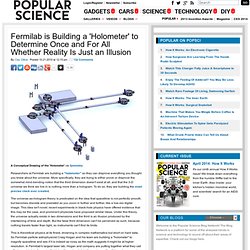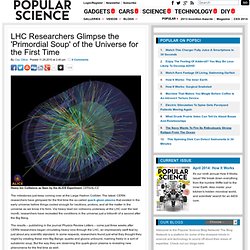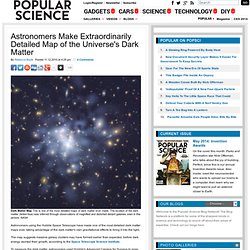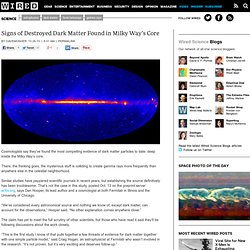

Particles can be quantum entangled through time as well as space. Entangled En Masse: Physicists Crank Out Billions of Entangled Nucleus-Electron Pairs on Demand. Entanglement, that most counterintuitive quantum phenomenon by which particles share an unseen link that aligns their properties, is looking more mundane all the time.

Just last week two groups of researchers reported entangling a photon with a crystal-based device, potentially paving the way for solid-state memories that can store and then release entangled particles as needed. Another week, another advance. Fermilab is Building a 'Holometer' to Determine Once and For All Whether Reality Is Just an Illusion. Researchers at Fermilab are building a "holometer" so they can disprove everything you thought you knew about the universe.

More specifically, they are trying to either prove or disprove the somewhat mind-bending notion that the third dimension doesn't exist at all, and that the 3-D universe we think we live in is nothing more than a hologram. To do so, they are building the most precise clock ever created. The universe-as-hologram theory is predicated on the idea that spacetime is not perfectly smooth, but becomes discrete and pixelated as you zoom in further and further, like a low-res digital image.
This idea isn't novel; recent experiments in black-hole physics have offered evidence that this may be the case, and prominent physicists have proposed similar ideas. How to Test What Really Happened After the Big Bang. A new test that takes data from several realms of physics could explain what really happened in the first sliver of a second after the Big Bang.

Most cosmologists believe the universe burst from an extremely dense, hot state around 13.7 billion years ago, and has been expanding and cooling ever since. The universe ballooned ridiculously fast in its first moments, doubling in size thousands of times in less than a trillionth of a trillionth of a second. “That would take a region the size of an atomic nucleus or a proton, and stretch it to a size exponentially greater than our observable universe at present,” said cosmologist Paul Steinhardt of Princeton University.
“Superlatives are not enough here. Missing Black Holes Cause Trouble for String Theory. By John Timmer, Ars Technica The results continue to pour out of the Large Hadron Collider’s first production run.

No Black Holes Formed at Large Hadron Collider. Dark Matter Rush: Physics Gives Gold Mine New Life. LEAD, South Dakota — The gold rush glow has long faded from South Dakota, but a different kind of precious material is drawing crowds to the Black Hills.

An old mine that produced billions of dollars in gold may be North America's best shot at finding dark matter.Until it closed in 2002, the Homestake Mine, nestled in the town that inspired the HBO drama Deadwood, was the oldest, largest and deepest mine in the western hemisphere.That tremendous depth makes Homestake the perfect hunting ground for rare, elusive particles that stubbornly refuse to interact with the rest of the world, like neutrinos and hypothetical particles that could explain dark matter.Similar detectors already exist in Italy, Japan, Canada and Minnesota.
But the 8,000-foot-deep pit possible at Homestake would be deeper than them all, nearly as deep as Mount St. Helens is high. Condensed matter: The supersolid's nemesis. X Particle Explains Dark Matter and Antimatter at the Same Time. A new hypothetical particle could solve two cosmic mysteries at once: what dark matter is made of, and why there’s enough matter for us to exist at all.

“We know you have to have these two ingredients to the universe, both atoms and dark matter,” said physicist Kris Sigurdson of the University of British Columbia, coauthor of a paper describing the new particle. “Since you know you need those ingredients anyway, it seems like a natural thing to try to explain them from the same mechanism.” LHC Researchers Glimpse the 'Primordial Soup' of the Universe for the First Time. The milestones just keep coming over at the Large Hadron Collider.

The latest: CERN researchers have glimpsed for the first time the so-called quark-gluon plasma that existed in the early universe before things cooled enough for neutrons, protons, and all the matter in the universe as we know it to form. Via heavy lead ion collisions underway at the LHC over the last month, researchers have recreated the conditions in the universe just a billionth of a second after the Big Bang. Www.iter.org/newsline/155/505. Upping the Anti: CERN Physicists Trap Antimatter Atoms for the First Time. It is the stuff that both science fiction and a good part of author Dan Brown's fortune are made of—antimatter.

A research group at CERN, the European lab for particle physics in Geneva, has managed for the first time to confine atoms of the stuff. Fleeting antimatter atoms have been produced in the lab for years, but until now the ability to trap the elusive atoms for detailed study has been out of reach. (The confined amounts of antimatter are many orders of magnitude smaller than that swiped from CERN by insidious plotters in Brown's Angels & Demons.) The new advance, published online November 17 in Nature by the ALPHA Collaboration experiment at CERN, is only a proof of principle—the anti-atoms have only been confined for less than two tenths of a second—but the research could set the stage for a new round of fundamental physics tests.
(Scientific American is part of Nature Publishing Group.) Antimatter held for questioning. Space–time cloak could hide events. Demonic device converts information to energy. Astronomers Make Extraordinarily Detailed Map of the Universe's Dark Matter. Astronomers using the Hubble Space Telescope have made one of the most detailed dark matter maps ever, taking advantage of the dark matter's own gravitational effects to bring it into the light.

The map suggests massive galaxy clusters may have formed earlier than expected, before dark energy stunted their growth, according to the Space Telescope Science Institute. To measure the dark matter, astronomers used Hubble's Advanced Camera for Surveys to snap pictures of the galaxy cluster Abell 1689, located about 2.2 billion light-years away. The cluster is so massive that its gravity warps the light from galaxies behind it, an effect called gravitational lensing. Faraway galaxies appear as warped smears or distorted blobs, like you would see in a funhouse mirror.
Dark Worlds: A Journey to a Universe of Unseen Matter [Interactive] String theory tackles strange metals. Signs of Destroyed Dark Matter Found in Milky Way’s Core. Cosmologists say they’ve found the most compelling evidence of dark matter particles to date, deep inside the Milky Way’s core.

There, the thinking goes, the mysterious stuff is colliding to create gamma rays more frequently than anywhere else in the celestial neighborhood. Similar studies have peppered scientific journals in recent years, but establishing the source definitively has been troublesome. That’s not the case in this study, posted Oct. 13 on the preprint server arXiv.org, says Dan Hooper, its lead author and a cosmologist at both Fermilab in Illinois and the University of Chicago. “We’ve considered every astronomical source and nothing we know of, except dark matter, can account for the observations,” Hooper said. “No other explanation comes anywhere close.” Physicists Say Graphene Could Create Mass. Erasing Dark Energy. Illustration by Mike Pick Against all reason, the universe is accelerating its expansion. When two prominent research teams dropped this bombshell in 1998, cosmologists had to revise their models of the universe to include an enormous and deeply mysterious placeholder they called “dark energy.”
For dark energy to explain the accelerating expansion, it had to constitute more than 70 percent of the universe. It joined another placeholder, “dark matter,” constituting 20 percent, in overshadowing the meager 4 percent that make up everything else—things like stars, planets, and people. Incoming Cosmic Rays Hit Record High. The Earth was pummeled with record-setting levels of cosmic rays in 2009. Measurements from NASA’s Advanced Composition Explorer (ACE) and other spacecraft found that more high-energy particles from galactic space penetrated the inner solar system in the last few years than at any other time since the beginning of the space age. The spike is almost certainly due to several weird aspects of the most recent solar minimum, and could be the start of a new normal for cosmic ray levels. “It’s sort of like everything’s working in the same direction right now, to allow cosmic rays greater access to the inner solar system,” said space scientist Richard Mewaldt of Caltech.
Mewaldt and colleagues published their findings Oct. 7 in Astrophysical Journal Letters. Superlaser fires a blank. From Fermilab, a New Clue to Explain Human Existence? - NYTimes. In a mathematically perfect universe, we would be less than dead; we would never have existed. According to the basic precepts of Einsteinian relativity and quantum mechanics, equal amounts of matter and antimatter should have been created in the Big Bang and then immediately annihilated each other in a blaze of lethal energy, leaving a big fat goose egg with which to make stars, galaxies and us.
And yet we exist, and physicists (among others) would dearly like to know why. Quantum Entanglement May Hold DNA Together, New Study Says. A new research paper brings new meaning to the joke that all science is just physics. A team of scientists at the National University of Singapore suggests that it is quantum entanglement that holds our DNA together. It's hard to prove, but it would be a potentially explosive finding, as Technology Review explains. In quantum entanglement, two objects are connected by an invisible wave, like an umbilical cord, that allows them to essentially share the same existence. When something happens to one object, it immediately happens to the other, no matter how far apart they are. Breaking time reversal symmetry with light. +Enlarge image +Enlarge image. Why Graphene Won Scientists the Nobel Prize. Physics Nobel Prize Goes To Andre Geim and Konstantin Novoselov For Graphene's Unusual And Useful Properties: Scientific American Podcast.
Fusion is reaching a state of maturing - ITER Newsline #148. Fundamental Physics Laws Change Depending on When and Where You Are, New Study Says. On the deceleration behaviour of black holes. Exotic matter : Insight : Nature. Beginning and End of the Universe. July 26, 2010 § Universe History. Law & Disorder: A Companion. Behold our dark, magnificent horror. There is, you have to admit, a sort of savage grace, a tragic and terrible beauty, to the BP oil spill. Like any good apocalyptic vision of self-wrought hell, the greatest environmental disaster in U.S. history has its inherent poetry. Big Bang Abandoned in New Model of the Universe. Researchers Achieve Quantum Teleportation Over 10 Miles of Empty. Scientists in China have broken the record for quantum teleportation, achieving a distance of about 10 miles, according to a new study in Nature Photonics. That's a giant leap from previous achievements. The feat brings us closer to communicating information without needing a traditional signal transmission, the researchers note.
Although it's called teleportation, no matter is really moved. Rather, the quantum state of one object is transferred to another object. It works by entangling two objects, like photons or ions. Until now, this has only been achieved with particles that are at most a couple hundred feet apart. In the latest experiment, researchers entangled two photons and zapped the higher-energy one through a special 10-mile-long free-space tunnel, instead of a fiber one. It worked because the team "maximally entangled" the photons, using spatial and polarization modes, according to Ars Technica. [Ars Technica] Quantum Physics Online.
"Twistor" Theory Reignites the Latest Superstring Revolution: Sc. The Extrasolar Planets Encyclopaedia. Hundreds of Possible Alien Planets Discovered By NASA Spacecraft. Bose–Einstein condensate. AtlasResults < Atlas < TWiki. Moon Phase. Is the Universe Leaking Energy? Monster' Black Holes Activate When Galaxies Collide. HyperPhysics. Scientists present first “bre. Did a 'sleeper' field awake to expand the universe? - space - 11. Saturn Lightning Superbolts Revealed in New Photos. "There Was No Big Bang!" Say Several Leading Cosmologists (A Gal.
Mass Transits: Kepler Mission Releases Data on Hundreds of Possi. Quantum Physics made simple. Big Bang Poured Out "Liquid" Universe, Atom Smasher Hints.